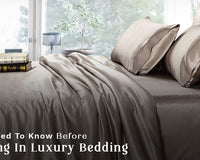Bedding products are essential for creating a comfortable and restful bedroom environment. But with so many options available, how do you ensure you're picking the right ones? Whether buying a new set of sheets or upgrading your duvet, shopping for bedding can sometimes feel overwhelming. But don’t worry – I’m here to help make the process easier.
In this guide, we’ll discuss the key factors to consider when shopping for bedding products so you can make informed choices. Let’s dive into the details and ensure you get the best bedding.
1. Material Matters: What Fabric Should You Choose?
Have you ever wondered why certain sheets feel more luxurious than others? The answer lies in the fabric. When shopping for single bedding, one of the first things you should consider is the material.

- Cotton: A classic favourite, cotton fitted sheet is soft, breathable, and durable. It's perfect for year-round use, keeping you cool in summer and warm in winter. Look out for options like Egyptian or Pima cotton for a luxurious feel.
- Linen: Known for its breathability and texture, linen is great for those who get hot at night. It has a relaxed, casual look and softens with each wash.
- Microfibre: A budget-friendly option, microfibre is soft and wrinkle-resistant. However, it may not be as breathable as natural fibres like cotton or linen.
- Bamboo: Eco-friendly and hypoallergenic, bamboo bedding is known for its silky feel and moisture-wicking properties.
Which material would suit your preferences? If you prioritise softness and durability, cotton might be your best bet. For a more luxurious feel, bamboo or linen could be ideal. Think about how you like to sleep and what will give you the most comfort.
2. Thread Count: Does It Really Matter?
You’ve probably heard that a higher thread count means better quality, but is that really true? While thread count can indicate softness, it’s not the only factor to consider.

Thread count refers to the number of threads woven into one square inch of fabric. Typically, the higher the thread count, the softer and more durable the sheets will be. However, once you go beyond 400-600 thread count, the difference in quality becomes less noticeable.
Aim for a thread count between 300 and 500 for a good balance of softness and durability. Higher isn’t always better—sometimes, a lower thread count in a premium fabric like Egyptian cotton can feel just as luxurious.
3. Weave Type: Percale or Sateen?
The way your bedding is woven can affect its feel. There are usually two main weave types: percale and sateen.

- Percale: Crisp, cool, lightweight, percale is excellent for hot sleepers or those who prefer a fresh feel.
- Sateen: Sateen is a beautiful choice after a silky, smooth texture. It’s warmer than percale and has a slight sheen, perfect for a more luxurious look.
Have you noticed a preference for crispness over softness in your bedding? If so, percale might be your best option. Sateen is worth considering for those who enjoy a softer, smoother texture.
4. The Right Size: Don’t Forget the Fit
When shopping for bedding, it’s important to choose the right size. This may sound obvious, but you’d be surprised at how often people end up with extra deep mattress fitted sheets that just don’t sit right on the mattress. Most bedding comes in standard sizes – single, double, king, and super king – but ensure you know your extra deep mattress protector measurements before buying.

Additionally, pay attention to the depth of your mattress. Do you have a thick mattress or one with a waterproof waterproof mattress protector? In that case, opt for deep-pocket Mattress Fitted Sheets ensure a snug fit.
5. Duvet Tog Rating: Stay Warm or Cool
Understanding the tog rating is crucial if you're shopping for a new duvet. The tog rating measures a duvet’s warmth, so choosing the right one depends on how warm or cool you like to be at night.

- 4.5 tog: Perfect for summer or if you tend to overheat.
- 10.5 tog: A great option for year-round comfort.
- 13.5+ tog: Ideal for the colder months or those who prefer extra warmth.
Do you feel cold easily, or do you prefer a lighter duvet? It’s important to match your duvet’s tog rating to your comfort needs and your climate.
6. Pillows: Soft, Medium, or Firm?
Your pillow plays a huge role in your sleep quality. Choosing the right pillow depends on your sleeping position:

- Side sleepers: A firmer pillow provides the support needed to align your neck.
- Back sleepers: Medium support pillows work well for maintaining a natural spine position.
- Stomach sleepers: A soft pillow helps prevent neck strain, offering a more comfortable sleep.
How do you usually sleep? If you’re a side sleeper, a firm pillow can prevent neck and shoulder discomfort, while back and stomach sleepers should opt for softer, more flexible options.
7. Allergies? Opt for Hypoallergenic Bedding

Do you suffer from allergies or sensitive skin? If so, it’s worth investing in hypoallergenic bedding. Materials like bamboo, organic cotton, and certain types of microfibre are naturally resistant to dust mites and other allergens. You can also look for bedding with anti-allergy treatments to ensure a healthier sleeping environment.
8. Care Instructions: Easy to Wash?
Finally, it’s important to consider the care requirements of your bedding. High-quality bedding often requires more delicate handling, such as cold washes or air drying. Ensure you’re comfortable with the care routine before committing to a particular bedding set. Some materials, like microfibre, are low-maintenance, while others, like linen, may require more attention.
9. Aesthetic Appeal: Choose a Style You Love
Your bedding is not just functional – it’s also a big part of your bedroom’s aesthetic. Consider the colour, pattern, and overall look of your bedding. Do you prefer a minimalist, neutral palette, or are you drawn to bold patterns and rich colours?
Take the time to think about what styles make you feel relaxed and comfortable. After all, your bedroom should be a calming retreat, and your bedding plays a key role in creating that atmosphere.
Final Thoughts
- Shopping for bedding doesn’t have to be complicated. By focusing on key factors such as material, thread count, weave, and tog rating, you can make the best choices for your comfort and needs. Whether you’re looking for something light and breathable for summer or a snug duvet to keep you warm in the winter, these tips will guide you towards the right bedding products.
What’s the next item on your list? Bedding that suits your lifestyle and preferences awaits!
FAQs
-
How often should I replace my bedding?
Replacing your bedding every 18 to 24 months is recommended, depending on the quality and how often it's used. Sheets and pillow covers may need replacing sooner if they show signs of wear, such as thinning fabric or fading. Pillows and duvets should be replaced every 2 to 3 years to maintain optimal comfort and hygiene. -
What is the best bedding material for hot sleepers?
If you tend to overheat at night, natural, breathable materials like cotton, bamboo, or linen are ideal choices. These fabrics help regulate body temperature and wick away moisture, ensuring a cooler, more comfortable sleep. - How do I know which tog rating is right for me?
The best tog rating depends on the season and your personal preferences. For summer, a 2.5 tog summer duvet is lightweight and breathable, while a 10.5- tog duvet is suitable for year-round use. In winter, or if you prefer extra warmth, a 15 tog duvet will keep you cosy.


